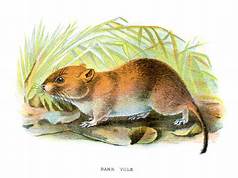
Salty Sam’s Fun Blog for Children
Number 466
Mangrove Swamps
Hello Everyone

lf you go for a walk in the woods behind auntie Alice’s cottage, you are sure to see animals and lots of birds living there.
lf you were to go there in the dark you are even more likely to see badgers and foxes because they are nocturnal (night) hunters. You might even see an owl or two.
Last weekend, l took Emily, Bill, Bob and Henry for a walk there to see how many different creatures we could see.
As we were walking, l told them that when l was a sailor travelling the world, l had come across forests where there were fish swimming amongst the trees.
That sounds strange, doesn’t it?
Of course, l am talking about mangrove swamps.
Mangrove swamps are places where salt-tolerant trees and shrubs grow.
lt is important that the shrubs that grow in these swamps are tolerant of salt; not many plants are.
The special word that means salt loving is halophytic.
Salty sea water rises between trunks and branches as the tide rises, and lowers when the tide goes out again. Sometimes, if mangroves grow where a river is flowing into the sea, the water is brackish. That means a mix of fresh water from the river and salty water from the sea.
Mangroves have adapted to living there. Mangrove trees excrete (push out) salt from their leaves to get rid of what otherwise would be too toxic to them.
There are mangrove swamps along the coastlines of Caribbean islands, Florida, the Gulf of Mexico and South East Asia; especially in lndonesia. But there are some with hardy species of plants (can tolerate cool temperatures) in New Zealand.
Mangrove swamps cover many tens of thousands of square miles of the planet surface and are immensely important to a lot of different species of wildlife above and below the water. They are found in tropical and subtropical areas of the world. Sediment is deposited in them from rivers and the sea creating a unique environment.
Nearly 75% of the coastlines of tropical countries have mangrove swamps. The ones with the greatest diversity (range) of creatures are in lndonesia and other areas of the western Pacific.
The swamps augment (get bigger) when the mangrove trees grow seeds which germinate while they are still hanging on the branch. The seeds then send down long shoots. When they drop, they are able to send out roots to establish themselves at an astounding rate. But it is possible that they could be washed away on a high tide and then grow into a new tree in another place.
ln this way, the mangroves can push their way out into the sea or establish new areas of growth. Once they start collecting sediment around their base they are actually building land and in places this can be done at a remarkable speed.
Mangroves have roots that are able to keep the tree upright in soft ground. Some types of mangrove tree put roots up vertically to get oxygen from the air above the top of the water. They look like lots of spikes coming up around the tree. There is not much oxygen in the sediment they are growing in.
There are three species of mangrove in Florida, the red, white and black, but sixty in the western Pacific area where mangroves are thought to have originated. Here, they are harvested for wood and also material for making paper.
Mangrove swamps are often impenetrable (difficult to get into) because the plants grow so closely together, but the trees don’t grow very tall like in the rainforest. They can be quite smelly places too because the rotting vegetation creates swamp gas which smells like rotten eggs.
Sea grass may grow between the trees giving another habitat for underwater creatures to live in. Sea grass is a very important marine environment.
You will find many different animals living in mangrove swamps. There will be fish, shrimps, shellfish, jellyfish, sponges, terrapins and crabs and very often small sharks, barracudas and rays which hide from bigger predators in the open sea.
The mangrove swamps are often thought of as shark nurseries. The sharks will be quite small when they emerge from their eggs and will stay safe in the shallow waters of the swamp. The habitat is a nursery for thousands of other fish species too.
You will find larger animals in the swamp too like, monkeys, bats, snakes, flamingos, pelicans and crocodiles. There will also be raccoons, deer, rabbits, eagles and herons, to name but a few.
The mangroves are always under threat from damaging hurricanes but also the expansion of human habitation along coastlines where they are cleared away for building houses and hotels or disturbed by agriculture. They are being lost much faster than rainforest.
Of course, they are also affected by pollution and oil spills at sea too.
Mangroves help humans. The thick mesh of the mangrove root systems helps to bind the ground together and stop coastal erosion. The barriers the plants create also calm down high waves as they hit the coast during a bad storm or an earth quake. Earth quakes at sea can cause tsunamis.
Mangrove swamps are also great carbon sinks – that means they are good at absorbing carbon dioxide.
Lots of mangrove swamps are now being protected because they are so important to the ecology of the world.
They are even being planted in some areas.
But it is thought that revitalizing damaged mangrove swamps is the best solution.
lf you like my blog, please support it by telling all your friends and followers about it.
Thank you!
And see you again next Fun Friday!
Love and kisses
Salty Sam

www.christina-sinclair.com


Bill and Bob’s Joke of the Week![]()
![]()
Bob: How do nut trees travel through the forest?
Bill: l don’t know. How do nut trees travel through the forest?
Bob: They take the psycho path.

Salty Sam © Christina Sinclair 2015
Unauthorized use and/or duplication of material from this blog without express and written permission from this blog’s author and owner is strictly prohibited.
Links may be used to www.christina-sinclair.com

Picture Gallery







 THE SALTY SAM NEWS DESK
THE SALTY SAM NEWS DESK

A couple of weeks ago, I was telling you about how our local vicar decided to take in some young people leaving social care so that they would have a home. His wife thought it was a good idea too and they set to work reconfiguring their home.
They thought they could take in three young people to give them a good start in adult life. They could stay for as long as they needed.
Young people in care are often moved around a lot; so they should be pleased to have a permanent home.
The vicar bought some new book shelves to put the books in his library into his study.
He is getting Reckitt and Stackett to convert the attic into a couple of bedrooms and put in another bathroom into his cleared-out library.
They have already started work because winter is not their busy time and it is nicer to work inside during the winter months.
Reckitt and Stackett, the Rocky Bay builders, have done a few attic conversions in Rocky Bay in recent years. They charged the vicar a very reasonable price when they knew what he wanted to do.
Betty Clutterbuck said that she could offer a first-time job to a young person in the Rocky Bay Tea Rooms.
Captain Jack and I offered to redecorate a first floor bedroom to help out. This was the third bedroom they were going to use.
Various people donated furniture for the newly-built bedrooms, and Captain Jack and I painted everything white in order to colour co-ordinate the pieces.
There will be plenty of storage for clothes, books and other personal items.
Auntie Alice, always keen to help a good cause, decided to make three patchwork duvet covers. She decided to make them on a sewing machine rather than by hand as it would be much quicker.
She would use the log cabin pattern. She would use bright, cheerful, welcoming colours.
She knitted some hats and gloves as well, to help kit out the new arrivals for the Rocky Bay winter, and boy has it been cold this week!
Now the vicar just has to make the arrangements.

Log cabin patchwork can be made by hand or sewing machine. Different effects can be achieved by using different patterns and colours.



*********************
TO ADVERTISE ON THIS BLOG
PLEASE CONTACT:
christina.sinclair.ads@aol.co.uk
*********************

 Quick Quiz
Quick Quiz
Can you work out what the following animals are?
(Not all of them live in mangroves.)
- M_U_E
- A_T_A_E_
- N_W_
- G_l_E_ P_G
- R_B_l_
- O_T_R
- V_L_
- E_E_H_N_
- S_A_E




lt’s the Weekend!

HOW TO MAKE A POT SCRUBBER
This is a brilliant way to recycle plastic waste.
Take about 6 fine net bags from packs of fruit and cut the two ends off each one.
Put the tubes around your arm so that you can line them up at one end.
Sew the uneven ends together in a bunch.
Roll the neater end down and sew each end of the sausage you have made.
Then press this down so you get a shape that looks more like a doughnut and sew into the centre to make your scrubber secure.

Never use these nets to hang up bird food because the birds can get tangled up and terribly injured!

Please note that the material on this blog is for personal use and for use in classrooms only.
It is a copyright infringement and, therefore, illegal under international law to sell items made with these patterns.
Use of the toys and projects is at your own risk.
©Christina Sinclair Designs 2015


Quick Quiz Answers
- MOUSE
- ANTEATER
- NEWT
- GUlNEA PlG
- RABBlT
- OTTER
- VOLE
- ELEPHANT
- SNAKE
 Bank vole
Bank vole


